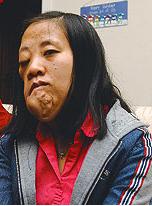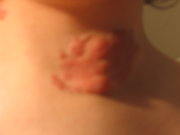Definition
Neurofibromatosis (NF), or von Recklinghausen disease, is a genetic disease in which patients develop multiple soft tumors (neurofibromas). These tumors occur under the skin and throughout the nervous system.
Description
Neural crest cells are primitive cells which exist during fetal development. These cells eventually turn into:
- Cells which form nerves throughout the brain, spinal cord, and body.
- Cells which serve as coverings around the nerves that course through the body.
- Pigment cells, which provide color to structures.
- The meninges, the thin, membranous coverings of the brain and spinal cord.
- Cells which ultimately develop into the bony structures of the head and neck.
In neurofibromatosis, a genetic defect causes these neural crest cells to develop abnormally. This results in numerous tumors and malformations of the nerves, bones, and skin.
Neurofibromatosis occurs in about one of every 4,000 births. Two types of NF exist, NF-1 (90% of all cases), and NF-2 (10% of all cases).
Causes & symptoms
Both forms of neurofibromatosis are caused by a defective gene. NF-1 is due to a defect on chromosome 17; NF-2 results from a defect on chromosome 22. Both of these disorders are inherited in a dominant fashion. This means that anybody who receives just one defective gene will have the disease. However, a family pattern of NF is only evident for about half of all cases of NF. The other cases of NF occur due to a spontaneous mutation (a permanent change in the structure of a specific gene). Once such a spontaneous mutation has been established in an individual, however, it is then possible to be passed on to any offspring. The chance of a person with NF passing on the NF gene to a child is 50%.
NF-1 has a number of possible signs and can be diagnosed if any two of the following are present:
- The presence of café-au-lait (French for coffee-with-milk) spots. These are patches of tan or light brown skin, usually about 5-15 mm in diameter. Nearly all patients with NF-1 will display these spots.
- Multiple freckles in the armpit or groin area.
- Ninty percent of patients with NF-1 have tiny tumors called Lisch nodules in the iris (colored area) of the eye.
- Neurofibromas. These soft tumors are the hallmark of NF-1. They occur under the skin, often located along nerves or within the gastrointestinal tract. Neurofibromas are small and rubbery, and the skin overlying them may be somewhat purple in color.
- Skeletal deformities, such as a twisted spine (scoliosis), curved spine (humpback), or bowed legs.
- Tumors along the optic nerve, which cause vision disturbance in about 20% of patients.
- The presence of NF-1 in a patient's parent, child, or sibling.
There are very high rates of speech impairment, learning disabilities, and attention deficit disorder in children with NF-1. Other complications include the development of a seizure disorder, or the abnormal accumulation of fluid within the brain (hydrocephalus). A number of cancers are more common in patients with NF-1. These include a variety of types of malignant brain tumors, as well as leukemia, and cancerous tumors of certain muscles (rhabdomyosarcoma), the adrenal glands (pheochromocytoma), or the kidneys (Wilms' tumor).
Patients with NF-2 do not necessarily have the same characteristic skin symptoms (café-au-lait spots, freckling, and neurofibromas of the skin) that appear in NF-1. The characteristic symptoms of NF-2 are due to tumors along the acoustic nerve. Interfering with the function of this nerve results in the loss of hearing; and the tumor may spread to neighboring nervous system structures, causing weakness of the muscles of the face, headache, dizziness, poor balance, and uncoordinated walking. Cloudy areas on the lens of the eye (called cataracts) frequently develop at an unusually early age. As in NF-1, the chance of brain tumors developing is unusually high.
Diagnosis
Diagnosis is based on the symptoms outlined above. Diagnosis of NF-1 requires that at least two of the listed signs are present. Diagnosis of NF-2 requires the presence of either a mass on the acoustic nerve or another distinctive nervous system tumor. An important diagnostic clue for either NF-1 or NF-2 is the presence of the disorder in a patient's parent, child, or sibling.
Monitoring the progression of neurofibromatosis involves careful testing of vision and hearing. X-ray studies of the bones are frequently done to watch for the development of deformities. CT scans and MRI scans are performed to track the development/progression of tumors in the brain and along the nerves. Auditory evoked potentials (the electric response evoked in the cerebral cortex by stimulation of the acoustic nerve) may be helpful to determine involvement of the acoustic nerve, and EEG (electroencephalogram, a record of electrical currents in the brain) may be needed for patients with suspected seizures.
Treatment
There are no available treatments for the disorders which underlie either type of neurofibromatosis. To some extent, the symptoms of NF-1 and NF-2 can be treated individually. Skin tumors can be surgically removed. Some brain tumors, and tumors along the nerves, can be surgically removed, or treated with drugs (chemotherapy) or x-ray treatments (radiation therapy). Twisting or curving of the spine and bowed legs may require surgical treatment, or the wearing of a special brace.
Prognosis
Prognosis varies depending on the types of tumors which an individual develops. As tumors grow, they begin to destroy surrounding nerves and structures. Ultimately, this destruction can result in blindness, deafness, increasingly poor balance, and increasing difficulty with the coordination necessary for walking. Deformities of the bones and spine can also interfere with walking and movement. When cancers develop, prognosis worsens according to the specific type of cancer.
Prevention
There is no known way to prevent the approximately 50% of all NF cases which occur due to a spontaneous change in the genes (mutation). New cases of inherited NF can be prevented with careful genetic counseling. A person with NF can be made to understand that each of his or her offspring has a 50% chance of also having NF. When a parent has NF, and the specific genetic defect causing the parent's disease has been identified, tests can be performed on the fetus (developing baby) during pregnancy. Amniocentesis or chorionic villus sampling are two techniques which allow small amounts of the baby's cells to be removed for examination. The tissue can then be examined for the presence of the parent's genetic defect. Some families choose to use this information in order to prepare for the arrival of a child with a serious medical problem. Other families may choose not to continue the pregnancy.
Key Terms
- Chromosome
- A structure within the nucleus of every cell, which contains genetic information governing the organism's development.
- Mutation
- A permanent change to the genetic code of an organism. Once established, a mutation can be passed on to offspring.
- Neurofibroma
- A soft tumor usually located on a nerve.
- Tumor
- An abnormally multiplying mass of cells.
Further Reading
For Your Information
Books
- Haslam, Robert H.A. "Neurocutaneous Syndromes." In Nelson Textbook of Pediatrics, edited by Richard Behrman. Philadelphia: W.B. Saunders Co., 1996.
Periodicals
- "Health Supervision for Children with Neurofibromatosis." Pediatrics 96, 2 (August 1995): 368+.
- Levy, Charles E. "Physiatry and Care of Patients with Neurofibromatosis." The Journal of the American Medical Association 278, 18 (November 12, 1997): 1493+.
- Waller, Amy L., and James E. Baumgartner. "Current Concepts in the Management of Neurofibromatosis Type 1." Physician Assistant 21, 8 (August 1997): 103+.
Organizations
- March of Dimes Birth Defects Foundation. National Office, 1275 Mamaroneck Avenue, White Plains, NY 10605. http://222.modimes.org.
- The National Neurofibromatosis Foundation, Inc., 95 Pine St., 16th Floor, New York, NY 10005. (800)323-7938. http://nf.org.
- Neurofibromatosis, Inc., 8855 Annapolis Rd., #110, Lanham, MD 20706-2924. (800) 942-6825.
Gale Encyclopedia of Medicine. Gale Research, 1999.




